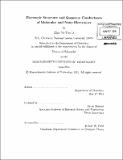Electronic structure and quantum conductance of molecular and nano electronics
Author(s)
Li, Elise Yu-Tzu
DownloadFull printable version (11.62Mb)
Alternative title
Electronic structure and quantum conductance of carbon-based nanoelectronics
Other Contributors
Massachusetts Institute of Technology. Dept. of Chemistry.
Advisor
Nicola Marzari.
Terms of use
Metadata
Show full item recordAbstract
This thesis is dedicated to the application of a large-scale first-principles approach to study the electronic structure and quantum conductance of realistic nanomaterials. Three systems are studied using Landauer formalism, Green's function technique and maximally localized Wannier functions. The main focus of this thesis lies on clarifying the effect of chemical modifications on electron transport at the nanoscale, as well as on predicting and designing new type of molecular and nanoelectronic devices. In the first study, we suggest and investigate a quantum interference effect in the porphyrin family molecules. We show that the transmission through a porphyrin molecule at or near the Fermi level varies by orders of magnitude following hydrogen tautomerization. The switching behavior identified in porphyrins implies new application directions in single molecular devices and molecular-size memory elements. Moving on from single molecules to a larger scale, we study the effect of chemical functionalizations to the transport properties of carbon nanotubes. We propose several covalent functionalization schemes for carbon nanotubes which display switchable on/off conductance in metallic tubes. The switching action is achieved by reversible control of bond-cleavage chemistry in [1+2] cycloadditions, via the 8p 3 8s p 2 rehybridization it induces; this leads to remarkable changes of conductance even at very low degrees of functionalization. Several strategies for real-time control on the conductance of carbon nanotubes are then proposed. Such designer functional groups would allow for the first time direct control of the electrical properties of metallic carbon nanotubes, with extensive applications in nanoscale devices. In the last part of the thesis we address the issue of low electrical conductivity observed in carbon nanotube networks. We characterize intertube tunneling between carbon nanotube junctions with or without a covalent linker, and explore the possibility of improving intertube coupling and enhance electrical tunneling by transition metal adsorptions on CNT surfaces. The strong hybridization between transition metal d orbitals with the CNT [pi] orbitals serves as an excellent electrical bridge for a broken carbon nanotube junction. The binding and coupling between a transition metal atom and sandwiching nanotubes can be even stronger in case of nitrogendoped carbon nanotubes. Our studies suggest a more effective strategy than the current cross-linking methods used in carbon nanotube networks.
Description
Thesis (Ph. D.)--Massachusetts Institute of Technology, Dept. of Chemistry, 2011. Cataloged from PDF version of thesis. Includes bibliographical references (p. 129-137).
Date issued
2011Department
Massachusetts Institute of Technology. Department of ChemistryPublisher
Massachusetts Institute of Technology
Keywords
Chemistry.